
Last year’s Aviation Geek Fest was awesome. This year is going to be even better. Meet and hear Boeing Historian Mike Lombardi speak, tour the factory floor (like literally on the floor, not on the balcony like with public tours) of the Boeing 767, 777 and 747-8 production lines, meet other aviation nerds and quite a bit more. Oh and guess what Boeing 747-8 has in production right now? That’s right, the very first Boeing 747-8 Intercontinental.
If you are going to be in the Seattle area on Saturday, October 23, 2010, you are on Twitter and this sounds like something you might be interested in, get ready! Only 45 tickets will be made available to purchase starting at 11am (PST) this Friday October 15th for $20.00. Once they are gone… they are gone! The event is being hosted at the Future of Flight and will all take place at Paine Field.
If you are not able to make it, do not worry. You will be able to follow on Twitter and I am sure there will be a blog written up on it as well.
LEARN MORE ABOUT THE SCHEDULE AND GETTING YOUR TICKETS HERE.
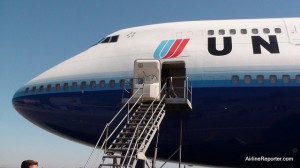
It is super sweet to board a Boeing 747-400 from the tarmac. Hold on...it's a long way up. Click for larger.
I have never flown on the upper deck of a Boeing 747. I have flown plenty of times on the lower level, but I have never had the opportunity to climb those stairs (photo) to the upper echelons of air travel.
Well, I still haven’t flown on the upper deck of a 747, but now I have been up in one. I have to admit, it is pretty darn awesome. During my recent trip to Los Angeles International Airport (LAX) to hang out with United Airlines, I was invited to check out the top deck and cockpit of one of their Boeing 747-400’s that was being set up for a 15 hour flight to Sydney, Australia.
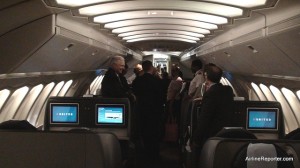
Ah. The upper deck of a Boeing 747-400. Great seats, total exclusivity and an amazing view. Click for larger.
The upper deck is a world of its own. Even though there were only about 30 people (invited guests, United employees and cleaning crew) it was obviously quieter up top. Speaking with a flight attendant she said she loves working the top deck since it has a more laid back atmosphere than the much longer bottom deck. All the seats on this United 747 upper deck were International Business Class — which weren’t too shabby at all. The First Class Suites were all located in the nose section on the bottom deck (photo). Yea, the location isn’t as cool as the upper deck, but those first class seats are crazy-big.
Anyhow, back up top, the seats and service might be pretty slick, but the coolest part is up front… the cockpit. The cockpit isn’t just for flying, there is a lot of room to invite guests and take a nice little nap. Heck, I think it might have had more square footage than my first apartment (ok not really). Part of the cockpit houses a set of bunk beds for pilots (photo) to get some rest. There is also plenty of extra seating for the relief pilots. Flights over 8 hours will require one relief pilot and flights over 12 will require two. So there needs to be plenty of room up front for everyone to be comfortable and well rested.
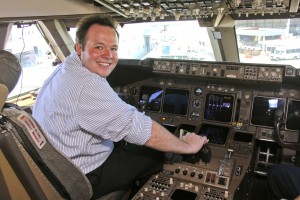
Heck yes. The best seat in the house! Click for larger.
The Boeing 747 is one of my favorite aircraft. Even though the Airbus A380 might be larger and carry more people, it just doesn’t have the same awesome presence that the Boeing 747 does. I am very excited for Boeing to introduce the new Boeing 747-8 Intercontinental (video), which will allow the Boeing 747 to fly well into the future.
A special thanks for United and their employees for flying me down to LAX to enjoy this and other fun adventures.
More Goodies:
* All the photos from my LAX visit with United.
* Time lapse video of new Business/First class seats being installed in a UAL Boeing 747-400
* Video from United 747-400 upper deck of take off from Chicago.
* Photo of United Boeing 747-400 in original Tulip livery in 1989
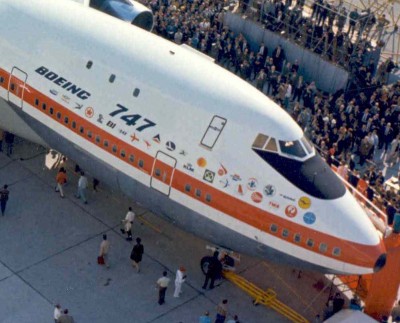
The first Boeing 747 with all those airline logos -- how many do you recognize. Click for larger. Photo by Boeing.
September 30th marked the anniversary when the very first Boeing 747 (called the City of Everett) was rolled out of Boeing’s hangars. Since then, it has been a legend and still is my favorite airliner. The Boeing 747 started flying for PanAm in 1970 and the new variant, the Boeing 747-8 should be delivered during the middle of next year. This means the Boeing 747 should continue to be flying well into the future.
Boeing kindly shared via Twitter a photo of the first roll out. It is interesting to take a look at the airline logos on the aircraft and how many are no longer with us and there are some still flying Boeing 747’s. The first Boeing 747 is still alive and well, hanging out at the Museum of Flight in Seattle.
So, without looking it up in Google, how many airline logos can you recognize? It is not really a competition, but let’s do some teamwork to figure them all out. If you know some, list them in the comments and hopefully we can get them all. Off the top of my head I know 18 of the 27 that are there. SEE LARGER VERSION.
Thanks @skhwang for point this out!
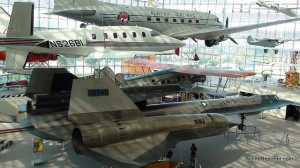
Alaska Airlines DC-3, Lear Fan 2100 hang from the ceiling, while an SR-71 and United Airlines Boeing 80A-1 hang out on the ground at the Museum of Flight
Over the past ten years I have (almost) consistently lived no farther than 30 miles away from the Museum of Flight (MoF) at Boeing Field in Seattle. However, I haven’t visited once in that last ten years. Being so close has been the problem. I have always thought, “well, I can go next weekend,” but I haven’t. I took such a wonderful aviation museum for granted and never went to re-discover what they have.
Well, I got sick and tired of hearing about all the cool new things they have and decided to go check them out myself. I was lucky to have Ted Huetter, Public Relations and Promotions Manager, show me around the place. Ted might work in PR, but there is no question he is an aviation nut and knows his stuff!
Last time I visited the MoF, they had a bunch of hanging airplanes (which don’t get me wrong are cool enough) and the old red Boeing barn. Today, not only do they have all that cool stuff still, but also their airpark, World War I and II displays and lots of nifty space stuff.
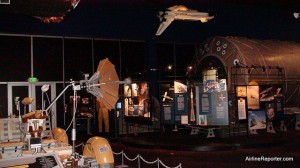
Lunar Rover on the left. Space station module on the right. Awesomeness all around.
The MoF started in 1964 when a small group of people set about wanting to maintain the history of aviation. The first aircraft obtained was displayed in the Seattle Center, where the Seattle Worlds Fair occurred in 1962. In 1975 the Port of Seattle leased the land the museum is currently on for 99 years (so better hurry before 2074). The Red Barn, which is the birthplace of The Boeing Company, was saved from demolition on its original location on the Duwamish River, and floated by river-barge to its current location.
The museum has a mission to “acquire and conserve a valuable collection of artifacts relating to air and space history and technology.” But they also want to ensure that the public can get access. This is a difficult mixture, since people are destructive. Not just the hooligans who literally cause damage, but just breathing and touching items or even air and sunlight can be very destructive over time. It is a hard balance of what aircraft to give patrons access to versus which ones must remain off-limits to keep them in tip-top condition over time.
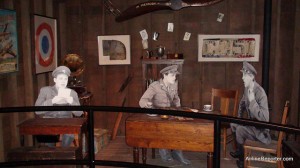
The Personal Courage Wing had much more than just airplanes. Really makes you feel like you travel back in time.
Even before I was able to make it into the lobby I was presented with eye candy outside. First they have a few aircraft on display, second you are right on Boeing Field, where the new test Boeing 787 Dreamliners and Boeing 747-8Fs are being housed, and lastly there were three Boeing 737-800 fuselages that were sitting on a train just outside the museum coming from Kansas and on their way to Renton, WA to be assembled.
After making it into the lobby you not only see aircraft hanging from the ceiling, but a vast gift shop with lots of great aviation related items (Even though Visa really wanted me to visit, I stayed away). They also have a theater off the lobby with great short movies, that you could probably just sit and watch all day without going through the rest of the museum.
When you first walk into the main “admissions only” area, you can’t help but get goose bumps. There are so many amazing aircraft hanging from the ceiling and on the ground for you to check out. From the SR-71 Blackbird to a DC-3 with Alaska Airlines livery. If you like aviation, you are going to love the collection of commercial and military aircraft they have on display.
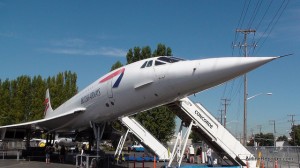
British Airways Concorde G-BOAG in the airpark
Off from the main floor is their Rendezvous in Space area and what a cool section. From a lunar rover to a full mock-up of a space station module that you can go inside of. The module is very interesting because there is no obvious “up.” Since there is no gravity, there is no floor and the signage for the buttons reads in different directions.
The way they have the area set up, it really puts you in a space-like setting, which makes the experience all that much more enjoyable. The museum is currently working to bring one of the space shuttles to their facility. You can sign a petition or donate to help their efforts and help Seattle get a Space Shuttle — and what city wouldn’t want to get a Space Shuttle?
After checking out Rendezvous in Space, it was off to the Personal Courage Wing that looks at the history of World War I and II. This is a new addition to the museum with two stories of history. They not only display amazing aircraft from both wars, but also share much more history about the time period and really put the aircraft into perspective. Even if you don’t like airplanes, but enjoy history, you will love this section of the museum (double bonus if you like both).
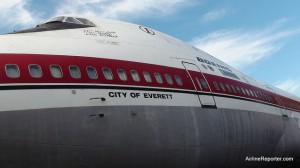
You are able to walk around the first ever Boeing 747, the City of Everett
My guide, Ted, told me that people always ask why World War II aircraft are downstairs (where you enter) and WWI are upstairs. He explained that it was all about weight. The aircraft from the earlier time period were much lighter than those from WWII, having it make more sense to store the lighter aircraft upstairs.
Now, it was time to head outside to their airpark to check out some pretty sweet airliners. First we went inside British Airways Concorde (G-BOAG). This was my first time inside a Concorde and it looked brand new still. The windows were super small and it was a little cramped, but not as bad as I expected. You are able to see in the cockpit and the few hundred fuses they have on the wall.
Having one of the remaining super-sonic airliners that is in such great shape is pretty exciting. Upon exiting, it was time to check out old Air Force One 707-120 that replaced Eisenhower’s Super Constellation. Ted explained that flight engineers, who used to work on the plane, recently came for a visit and they said the plane smells exactly the same as it did back in the day. Now, that is preserving history!
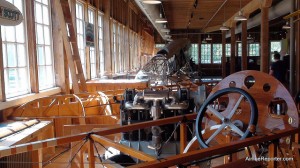
Inside the Boeing Red Barn at the Museum of Flight
Even though the Concorde and Boeing 707 are in pristine condition and you can go inside, the jewel of the airpark (in my opinion) is the first Boeing 747 (N7470). It is named the City of Everett after where it was built at Paine Field, located in Everett, WA. It first flew on February 9, 1969 and later served as a testbed for 747 systems improvements and new engine developments for other Boeing commercial jets, including the Boeing 777 engine program. She is not in the best shape, but that is something the Museum of Flight hopes to work on.
If you are into researching about planes, the MoF also has a public archive and library that you are able to visit. If you are in the Seattle area on October 9th or 10th, make your way to the Library and Archives Building, because they will be having a sale of a bunch of old aviation related books and other goodies.
There is so much more to explore at the MoF, an aviation nut could easily spend a few days there. For those of you who are local, it might be time to re-discover the Museum of Flight. For those of you that don’t live in the Seattle area, make sure to put this on your “must do” list and if you love aviation, you have to make it out to Seattle sometime to check out all the cool things we have to offer.
MORE PLEASE:
* 91 Photos I took during my trip
* Video with Harrison Ford (he loves aviation) promoting the Museum of Flight
* They have a vast collection of airline logos
* Friend the Museum of Flight on Facebook
* Follow them on Twitter
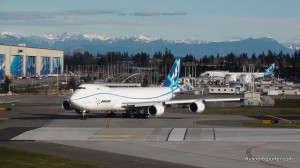
The first Boeing 747-8 completes taxi tests at Paine Field
Not that long ago Boeing entered into the world of social media and I wanted to take a moment to see how it is going.
Personally, I have seen huge changes in the past six months in regards to Boeing and social media. They have come an extremely long way when it comes to connecting with regular people like me and you since I started this blog just over two years ago. By making a huge push, I think they have been highly successful. However, I wanted to see how Boeing feels about their progress.
I decided to speak with Todd Blecher, Communications Director at Boeing based in Chicago, and Bernard Choi, who works for the Communications Department for Boeing Commercial Airplanes in Seattle, to hear their take on Boeing’s progress.
When I asked Blecher if he felt their efforts have been successful he responded with: “I look at success on two levels. The first is whether we consistently generate appealing digital content. The reactions we’ve received since we started using Boeing.com as a storytelling platform and engaging through Twitter lead me to believe that we do.”
Blecher admitted that he wished their numbers were a little higher for the unique content they are creating on their website, but they were very happy with how their efforts at Farnborough turned out. “Our Farnborough micro site was a watershed moment, coming just a few months after we began communicating differently through Boeing.com,” Blecher stated. “We attracted 103,710 visitors who made more than 225,000 visits and 222,300 views of our videos. That was remarkable for us. I’m very proud of that effort.”
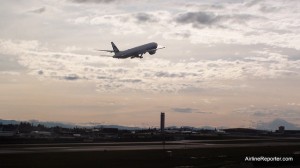
A new Cathay Pacific Boeing 777 test flying at Paine Field
On top of making a lot of great and unique content on their website, Boeing has also been making a great effort to interact with their employees, different airlines and fans on Twitter.
I have found that a lot of companies don’t know how to make Twitter work for them. Many will have a Twitter account because they feel they need one, but they don’t know why. Talking with Blecher, I can tell he gets it. “Social media’s value rests in allowing organizations to engage in a dialogue with people around the world that can benefit both sides of that equation, and do that at very low cost,” he explained. Boeing is not on Twitter because they want to look like they are in-touch, they are on Twitter because they want to change how they communicate to the outside world (being media, airlines and fans like you) permanently and more effectively, using technology.
Working Boeing’s three Twitter accounts (@BoeingAirplanes, @BoeingCorporate and @BoeingDefense) is very much a team effort. Blecher watches over @BoeingCorporate, Choi works on @BoeingAirplanes and Maribeth Bruno in Boeing Defense Communication watches over @BoeingDefense. I know that some larger companies have to go through a lot of hurdles to get something posted to Twitter, but Boeing makes it easy.
I have heard of horror stories from other companies, where they want to Tweet something, but it has to be approved half way around the world by five different people. It might take up to 12 hours to finally Tweet and by then, the moment is lost.

Boeing's hangars in Everett, WA (don't worry I was passenger when taking this photo)
Blecher pointed out that Boeing is actually pretty flexible with allowing people to Tweet. All three of them that oversee the Twitter accounts are trained professionals and are able to use their own judgment on what is alright to Tweet. “Since our tweeters are media relations people by trade we all know what’s ok and what’s not ok for a tweet.” Blecher continued, “We’re used to being on a high wire without a net, so to speak. Therefore, most of our tweets aren’t subjected to lengthy review.”
He did clarify that if a Tweet is program related (ie what the 787 might be doing), they will speak with people in that department to make sure they have accurate information. On rare occasions there might be longer discussions before a Tweet goes public.
Choi explained that he might confer with a colleague, but he has the ability to use his judgment when to make a Tweet go live, “I’ll bounce ideas off of my colleagues, but there isn’t an official approval process.” There is a lot going on at Boeing all the time and it can’t all be Tweeted. I asked Choi how he gets his information, like when Randy Tinseth posts a new blog, does he get a heads up? He explained that sometimes he might, “get a heads up that Randy’s got a new blog coming or I’ll just wait like everyone else. I don’t tweet every blog entry, just as I don’t tweet every Boeing news release. It’s fairly subjective. We don’t want to overtweet, so we look for the highlights or just interesting nuggets to tweet. As you can imagine, we’re still learning as we go.” And Boeing has been learning.
Let’s take a look at what happened just last night. Boeing knew it was going to have to announce that the Boeing 787 will be delayed again. They posted their press release and Tweeted out the delay pretty much at the same time. Even though there were rumors that Boeing would release this information, they were the first one on Twitter to have the official confirmation. It was about another 15 minutes before other Twitter people responded to their original Tweet. That is being proactive and not everyone would be willing to Tweet out bad news like that.
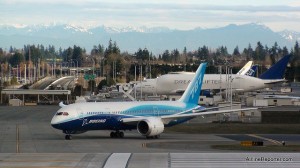
Boeing 787 Dreamliner ZA001 during its taxi testing with Dreamlifter in the background.
Boeing has learned a lot from their interactions on Twitter, from posting online media and their Boeing Store Facebook account. They are hoping to use that information to continue to grow their online presence. They hope to launch an official Boeing Facebook page (there is currently an unofficial one with 30,000 fans) and YouTube channel to share videos with the public and believe me, they have some really cool stuff.
Speaking about cool stuff, Boeing is still hip with the idea of having a TweetUp sometime. That is where a bunch of airline nerds like us (don’t take offense to that, just figure you might be one if you’re reading this) get together and talk about airplanes and do some cool things (there was one last year called Aviation Geekfest). One sponsored by Boeing won’t happen soon (there is a lot of red tape), but they are motivated to try and make it work someday (And I will continue to keep reminding them).
They are currently happy with the progress they have made, yet are still cautious about growing their online presence too quickly. “With any of these tools we have to walk before we run,” Blecher explained. “We’re far ahead of where I expected we’d be and while I’d love for us to be moving faster, I realize that trying to move too fast could put our efforts at risk. A couple of high-profile mistakes in the social sphere could really set us back.” That is a very wise approach to take. Many airlines have hopped on to the online bandwagon with great momentum, just to fizzle out with time and leaving people wondering what happened. You also don’t want to be venturing into new technology without fully understanding the impact it could have on your business or your customers.
From speaking with Blecher and Choi multiple times through their transition, I constantly get the feeling that they get it. They aren’t just pushing Boeing into the online realm because it is the new fad. Boeing is very well known for being innovative and cutting edge in many of the things they accomplish. Now they want to take that Boeing innovation mentality to the way they communicate with the outside world.














